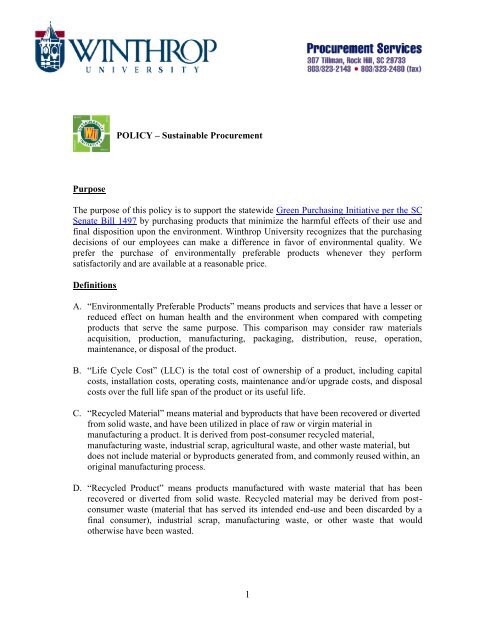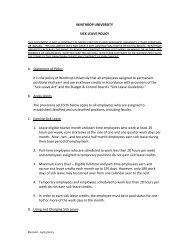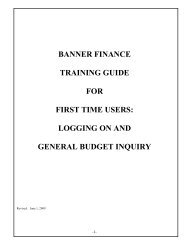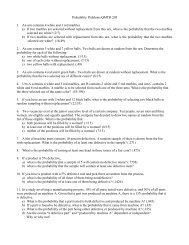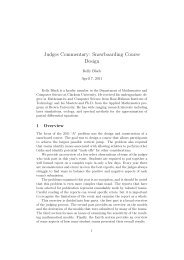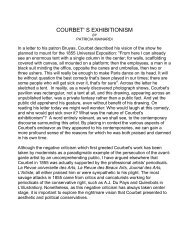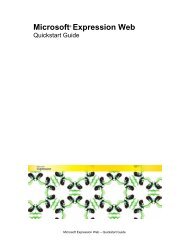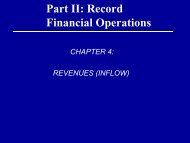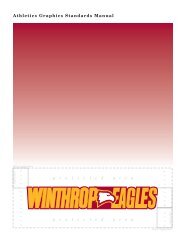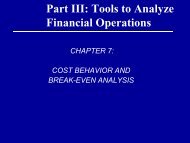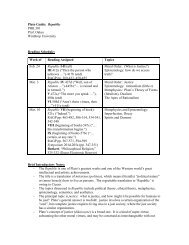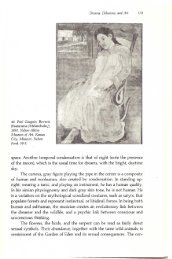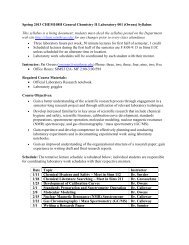Sustainable Procurement Policy - Winthrop University
Sustainable Procurement Policy - Winthrop University
Sustainable Procurement Policy - Winthrop University
You also want an ePaper? Increase the reach of your titles
YUMPU automatically turns print PDFs into web optimized ePapers that Google loves.
POLICY – <strong>Sustainable</strong> <strong>Procurement</strong>PurposeThe purpose of this policy is to support the statewide Green Purchasing Initiative per the SCSenate Bill 1497 by purchasing products that minimize the harmful effects of their use andfinal disposition upon the environment. <strong>Winthrop</strong> <strong>University</strong> recognizes that the purchasingdecisions of our employees can make a difference in favor of environmental quality. Weprefer the purchase of environmentally preferable products whenever they performsatisfactorily and are available at a reasonable price.DefinitionsA. “Environmentally Preferable Products” means products and services that have a lesser orreduced effect on human health and the environment when compared with competingproducts that serve the same purpose. This comparison may consider raw materialsacquisition, production, manufacturing, packaging, distribution, reuse, operation,maintenance, or disposal of the product.B. “Life Cycle Cost” (LLC) is the total cost of ownership of a product, including capitalcosts, installation costs, operating costs, maintenance and/or upgrade costs, and disposalcosts over the full life span of the product or its useful life.C. “Recycled Material” means material and byproducts that have been recovered or divertedfrom solid waste, and have been utilized in place of raw or virgin material inmanufacturing a product. It is derived from post-consumer recycled material,manufacturing waste, industrial scrap, agricultural waste, and other waste material, butdoes not include material or byproducts generated from, and commonly reused within, anoriginal manufacturing process.D. “Recycled Product” means products manufactured with waste material that has beenrecovered or diverted from solid waste. Recycled material may be derived from postconsumerwaste (material that has served its intended end-use and been discarded by afinal consumer), industrial scrap, manufacturing waste, or other waste that wouldotherwise have been wasted.1
PoliciesA. Whenever practicable, <strong>Winthrop</strong> <strong>University</strong> personnel will purchase recycled andenvironmentally preferable products. Personnel can utilize the State of SC Guide forRecycled Products when possible.B. <strong>Winthrop</strong> <strong>University</strong> should promote the use of recycled and other environmentallypreferable products by publicizing its procurement program.C. The <strong>University</strong>’s <strong>Procurement</strong> Department will make every effort to secure contracts withvendors that are environmentally conscientious.D. <strong>Winthrop</strong> <strong>University</strong> will procure environmentally preferable products and serviceswhere criteria have been established by governmental or other widely recognizedauthorities (e.g. Energy Star, EPA Eco Purchasing Guidelines).E. <strong>Winthrop</strong> will integrate environmental factors into the <strong>University</strong>’s buying decisionswhere external authorities have not established criteria.F. Examples of preferable practices or products:Compact fluorescent lamps (Energy Star Seal on package)Made of recycled materials, maximizing post-consumer contentDurable, as opposed to single use or disposable itemsNon-toxic or minimally toxic, preferably biodegradableHighly energy efficient in production and useManufactured in an environmentally sound, sustainable manner by companies withgood environmental track recordsCause minimal or no environmental damage during normal use or maintenance.Shipped with minimal packaging (consistent with care of the product), preferablymade of recycled and/or recyclable materialsRecycled paper and paper productsRe-refined lubrication and hydraulic oilsComputers and electric appliances (Energy Star Rated)Re-crushed cement concrete aggregate and asphaltCement and asphalt concrete containing glass cullet, recycled fiber, plastic, or tirerubberRemanufactured tires and products made from recycled tire rubberCompostGreen Seal cleaning productsEnergy saving productsWaste-reduced productsWater-saving productsOffice Supplies (marked with environmental sign)Replacing disposables with reusables or recyclablesTaking into account life cycle costs and benefitsEvaluating, as appropriate, the environmental performance of vendors in providingproducts and services2
G. This policy will be reviewed annually by the Sustainability Committee and the Office of<strong>Procurement</strong> Services.Responsibilities of <strong>Procurement</strong> Department<strong>Winthrop</strong> is committed to actions designed to conserve and protect the environment and willcontinue to implement those actions whenever possible and economically feasible. It is theresponsibility of the <strong>Procurement</strong> Department, in conjunction with all <strong>University</strong>departments, to promote the development and use of environmentally friendly products andservices through the following activities:A. Promote the use of existing inventory within each department by posting a “need” or a“have” on the <strong>University</strong>’s public Swap-N-Shop site.B. Review contracts, bids, and specifications for goods and services to ensure that,whenever possible and economical, they are amended to provide for the expanded use ofproducts and services that contain the maximum level of post-consumer reusable orrecyclable waste or recyclable content, without significantly affecting the intended use ofthe product or service.C. Consult with all user departments to identify new environmentally friendly products andservices as well as improvements/changes in industry standards that may impact theenvironment.D. Require/recommend the use of recycled materials and recycled products by incorporatingthem in bid specifications where practicable.E. Purchase from suppliers who provide environmentally friendly products and services orsuppliers who are environmentally sensitive in their daily operations.F. Seek new suppliers and encourage existing suppliers to review the manner in which theirgoods are packaged. Work with suppliers in the areas of reduction and reuse of packagingmaterials.G. Use cost/benefit analysis to arrive at the correct sourcing decision; one that remainseconomically practical, reflects effective purchasing practices, and satisfies therequirements of the user department.H. Make suppliers aware of the <strong>Winthrop</strong> <strong>Sustainable</strong> <strong>Procurement</strong> <strong>Policy</strong>.I. Develop tools to track goals, assist in identifying and financially justifying greenproducts and services, make it easier to measure achievement of goals, and integrategreen purchasing into every day decisions.J. Utilize the <strong>Sustainable</strong> <strong>Procurement</strong> checklist (see below) for use in <strong>University</strong>purchasing.K. Participate in training for implementing and improving the procurement ofenvironmentally friendly products.3
L. Recommend legislation that will further support sustainable procurement.M. Acquire signatures on <strong>Sustainable</strong> Purchase <strong>Policy</strong> of all employees who have <strong>University</strong>purchasing cards.Responsibilities of DepartmentsA. Departments should use the list in this policy as a guideline for environmentallypreferable products, specific to their department/mission. They should add or modify thislist as necessary. Factors that should be considered when determining theenvironmentally preferable good or service include, but are not limited to:Maximization of recycled products used in product or service life cycleEnvironmental cost of entire product or service life cycleReuse of existing products or materials in product or service life cycleRecyclability of productMinimization of packagingReduction of energy/water consumptionToxicity reduction or eliminationElimination of uncertified hardwoods in product or service life cycleDurability and maintenance requirementsUltimate disposal of the productB. Inform employees of their responsibilities under this policy; provide them withinformation about recycled products and environmental procurement opportunities.Check the <strong>Procurement</strong> Web Page http://www.winthrop.edu/procurement for frequentupdates on vendor participation with environmental efforts.C. Establish a yearly review committee to evaluate the efforts the department has made tohelp protect and preserve the environment and what the future goals are for the upcomingyear.D. Submit new ideas or suggestions to <strong>Procurement</strong> Services.4
ExemptionsNothing in this policy shall be construed as requiring a department, agency or contractor toprocure products that do not perform adequately for their intended use or are not available ata reasonable price and in a reasonable period of time.Environmentally Preferable Purchasing (EPP) ResourcesA. EPA’s Comprehensive <strong>Procurement</strong> Guidelineshttp://www.epa.gov/cpg/B. EPA’s EPP Web Sitehttp://www.epa.gov/oppt/eppC. EPPNethttp://www.nerc.org/eppnet.htmlD. Green Sealhttp://www.greenseal.orgE. EnergyStarhttp://www.energystar.govF. Office of the Federal Environmental Executivehttp://www.ofee.govApproved December 5, 2012, by <strong>Winthrop</strong> <strong>University</strong> Executive Officers.5
<strong>Winthrop</strong> <strong>University</strong> <strong>Sustainable</strong> <strong>Procurement</strong> ChecklistWhen purchasing, ask a supplier these questions. But first, determine if the product or serviceis truly necessary. Purchasing will need to be balanced with issues of product performance,cost, and availability.(1) Waste reduction: Is the product durable? Can it be easily and economically servicedand maintained? Is the product designed to reduce consumption and minimize waste? Isthe product reusable? Is the product technically and economically recyclable in theimmediate area? Do facilities and internal collection systems exist to recycle theproduct? Can the product be returned to the supplier at the end of its useful life? Is theproduct compostable and are systems in place to compost the product on or off-site?Will the product biodegrade over time into harmless elements?(2) Packaging: Is the product necessary? Can it be eliminated? Is minimal packagingused? Is the product packaged in bulk? Is the packaging reusable or recyclable? Arerecycled materials used to produce the packaging and at what percent post-consumerwaste? Can the packaging be returned to the supplier? Is the packaging compostable?(3) Material source: Are recycled materials used in the product? If so, what percentage?What percentage of post-consumer materials is used? If wood is used in the product,what is its source and how is it harvested? Is the product manufactured from tropicalrainforest wood?(4) Energy efficiency: Is the product energy efficient compared to competitive products?Can the product be recharged? Can the product run on renewable fuels? Does theproduct require less energy to manufacture than competing products?(5) Supplier environmental record: Is the company producing the product in compliancewith all environmental laws and regulations? What is the company’s record in handlingenvironmental and safety issues? Can the company verify all environmental claims?Does the manufacturer/supplier have a company environmental policy statement? Whatprograms are in place/planned for promoting resource efficiency? Are printed materialsavailable documenting these programs? Has the company conducted an environmental orwaste audit? Is the product supplier equipped to bid and bill electronically? Has anenvironmental life-cycle analysis of the product (and its packaging) been conducted by acertified testing organization, such as Green Seal?Submitted November 15, 20126


